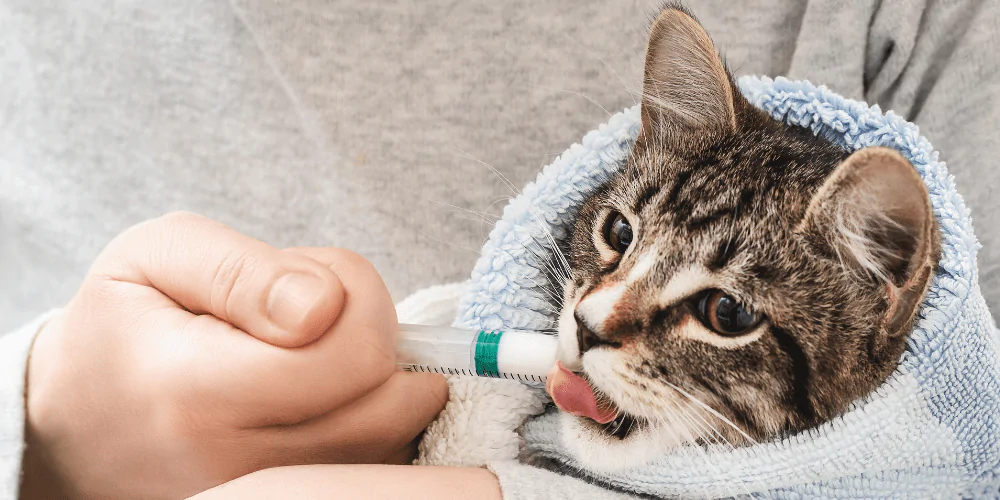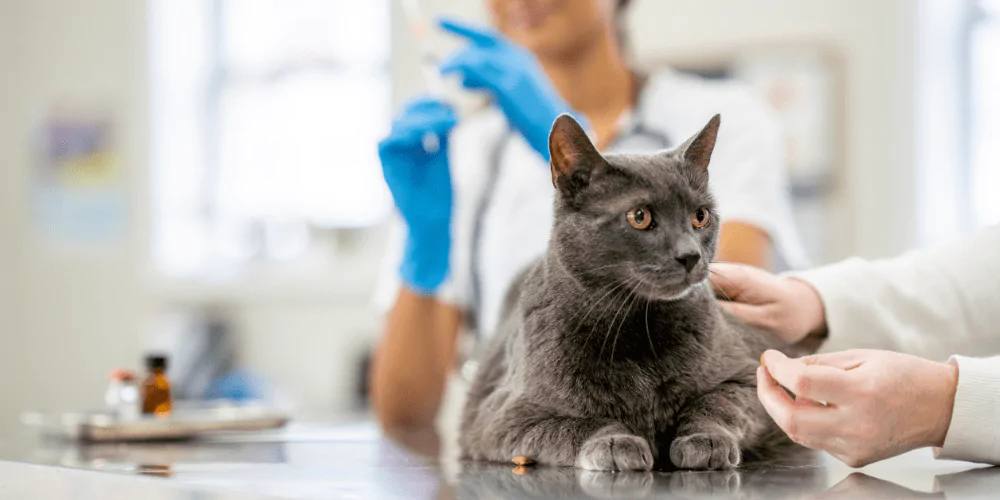
How to give your cat medicine

Dr Corinne Wigfall BVMBVS(Hons) BVMedSci(Hons)
30 January 2024 | 6 minutes read
Cats are independent at the best times but their stubbornness takes on a whole new level when it’s time to get their medicine.
You’re not alone if the process makes you nervous and stresses out your cat. Below, expert vet Dr Corinne shares her tips and tricks to help you calmly give your feline their treatment.
- Before you give your cat medicine
> What are the different types of medicine for cats? - Preparing to give your cat medicine
- How to give your cat different kinds of medicine
> How to give your cat tablet medicine
> How to give your cat liquid medicine
> How to give your cat topical medicine
> How to give your cat injections - What to do when your cat is scared of medicine

Before you give your cat medicine
Hopefully, you have a positive relationship with your vet. Always remember that they are there to support you with your cat’s physical well-being.
Your vet will talk you through the medication to be given and any potential side effects. They can offer you tailored advice on handling methods and answer any questions you have.
Even the most seasoned parents can struggle with knowing how to give medication to their pets. And every cat is unique, so what works for one feline may not be the right way for another.
Some cat insurance providers offer free access to vet video calls. This can be handy if you want an expert there to help guide you when giving medication at home.
> What are the different types of medicine for cats?
Your cat will likely have various treatments throughout their life, both for preventative and medical reasons. This could include:
- Flea and worming
- Appetite stimulants
- Ear drops
- Hairball aids
- Antibiotics
- Anti-inflammatories
- Painkillers
These treatments come in different forms, including:
- Oral, which are swallowed by your cat – tablets, capsules, and liquid suspensions
- Topical, applied to your cat’s skin – ointments and drops
- Injections for more severe illnesses and chronic conditions
Some of these will be given by your vet while others can be done at home.

Preparing to give your cat medicine
Before you begin, focus on creating a relaxed and comfortable set-up for you and your cat.
- Find a quiet, secure place where you can both relax away from noise and distractions. Close open windows to stop your cat from escaping and hurting themselves.
- Pick a spot that can be your regular ‘medicine-giving’ area – having a predictable place and routine can help to reduce your cat’s stress.
- Have any tools close at hand so you’re not unsettling your cat trying to reach for things.
- Think about having someone there your cat knows to help you with the process.

How to give your cat different kinds of medicine
Taking your time and keeping a calm approach with your cat is key to success. Offer lots of gentle praise while you’re giving them their medicine, then a high-value treat afterwards.
Remember to follow all instructions that your vet gives you or which come with the medication packet. Keep in mind that some felines will naturally be more relaxed with some methods, while others may take more work and patience.
> How to give your cat tablet medicine
Giving a cat a tablet can be notoriously tricky, but here’s what to do:
- Calmly and gently restrain your cat, holding them upright on a non-slip surface. You can also wrap their legs and body in a medium-sized soft towel, leaving only their head out.
- Gently but firmly hold their head with your dominant hand, using your thumb and forefinger to carefully open their jaw.
- Tilt your cat’s head up and place the tablet as far back on the tongue as you can. Close their mouth and gently rub their throat to help the tablet go down.
If this is a struggle, you can also try:
- Poking a hole inside your cat’s favourite treat, placing the tablet inside, and then wrapping it up for them to eat. Make sure they’ve swallowed the tablet and not spat it back out.
- If agreed with your vet, crush up the tablet and mix it with a small amount of wet food. Check they’ve eaten the whole meal. Don’t bake or cook the medication into treats as this can deactivate them.
> How to give your cat liquid medicine
Liquid medication can be a bit easier than tablets but still needs a bit of practice:
- As with tablets, gently but firmly restrain your cat on your lap.
- Carefully open your cat’s mouth with your thumb and forefinger.
- Take the syringe and squirt the medicine into the pocket of their cheek.
Some liquid medicines can be mixed into meals – just make sure your cat eats the whole meal to get the full dose.
> How to give your cat topical medicine
Applying topical treatments is normally easiest when done as follows:
- Gently hold your cat in your lap.
- Carefully apply the gel or cream on the affected area, using the amount specified by your vet/on the packet.
> How to give your cat injections
Giving an injection needs a good level of commitment and confidence. Always follow your vet’s guidance closely when it comes to using needles.
To give your cat their injection:
- Pinch some loose skin along your cat’s back with your forefinger and thumb.
- Holding the syringe firmly in your dominant hand, angle the needle down and insert it into the skin fold.
- Push down the plunger to give the needed amount of treatment and then remove the needle and syringe together.
- Give the area a little massage to relieve the sting.
Here are a few other general tips:
- Try distracting your cat with a treat as the injection is given.
- Inject quickly to minimise the risk of your cat moving.
- Try to inject into different skin folds each time, as this will be less painful for your cat.
- Always dispose of needles in the appropriate sharps container.

What to do when your cat is scared of medicine
Some cats may become fearful and even aggressive around medication. Speak to your vet if you’re struggling to give them their medicine. They can either help you directly using professional techniques or suggest alternative options. Examples include gels or daily visits to give the medications to your cat for you.
Long term, your vet can work on training methods with you to adjust your cat to taking medications without the stress or fuss. This often takes time and may include anti-anxiety medications.


